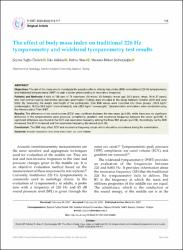The effect of body mass index on traditional 226 Hz tympanometry and wideband tympanometry test results
Künye
Öztürk, Ş. T., Külekçi, E. Abacı, K. ve Şerbetçioğlu, M. B. (2020). The effect of body mass index on traditional 226 Hz tympanometry and wideband tympanometry test results. The Turkish Journal of Ear Nose and Throat, 30(4), 113-117. https://doi.org/10.5606/Tr-ENT.2020.69885Özet
Objectives: The aim of this study was to investigate the possible effects of body mass index (BMI) on traditional 226 Hz tympanometry
and wideband tympanometry (WBT) to gain a better understanding of resonance frequency.
Patients and Methods: A total of 158 ears of 79 volunteers (19 males, 60 females; mean age: 20.5 years; range, 18 to 27 years)
who had normal hearing and normal otoscopic examination findings were included in the study between October 2019 and June
2020. By measuring the weight and height of the participants, their BMI values were classified into three groups: ≤18.5 kg/m2
(underweight), 18.5 to 24.9 kg/m2
(normal weight), and ≥25.0 kg/m2
(overweight). Tympanometric evaluations were conducted using
the Interacoustics-Titan WBT.
Results: The difference of ear canal volume (ECV) was significant between the two sexes (p<0.05), while there was no significant
difference in the tympanometric peak pressure, compliance, gradient, and resonance frequency between the sexes (p>0.05). A
significant difference was found in the ECV and resonance frequency among the three BMI groups (p<0.05). Accordingly, as the BMI
increased, the ECV increased and the resonance frequency decreased (p<0.05).
Conclusion: The BMI may affect ECV and resonance frequency values which should be considered during the examination.


















